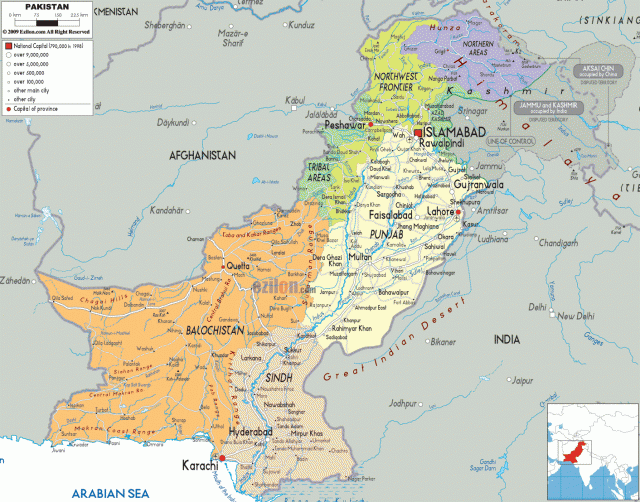Pakistan
Area 310,413 square mi (803,940 square km)
Population 185.0 million 2014
Capital Islamabad
Highest Point 28,251 ft (8,611 m)
Lowest Point 0 m
GDP $246.9 billion 2014
Primary Natural Resources natural gas, petroleum, coal, iron ore.
PAKISTAN CAME INTO being in 1947 when British colonial India, upon independence, was divided into Muslim-dominated East Pakistan (BANGLADESH as of 1971) and West Pakistan. Its 97-percent-Muslim population is divided between 75 percent Sunni and 25 percent Ithna'Ashariya (Shia), with a few of Isma'ili and Ahmadis. Parsis (Zoroastrians) and Christians provide the remaining proportion.

The official language is Urdu, a blend of Hindi, Persian, and Turkic languages, but the dominant language is Indo-European Punjabi (65 percent of speakers), followed by Sindhi (15 percent), Baluchi (10 percent), and Pakhto/Pashto (10 percent). A remnant of Dravidian languages, Brahui, is still spoken in the mountains of Baluchistan. Many languages, almost all non-literate, are spoken in the mountainous north. Burushaski, a language heretofore not connected to any other extant language is still spoken in the Hunza and Yasin valleys in the northern areas. English is spoken by 10 percent of the population. The coastal city of Karachi has a population of almost 12 million, while the ancient Mughal city of Lahore has 5 million, the capital conurbation of Islamabad/Rawalpindi 2.5 million, and western cities of Quetta .7 million and Peshawar .25 million.
GEOGRAPHIC CONNECTION
Although there is no direct cultural historical connection between the territory occupied by present day Pakistan with ancient times, there is a geographic connection. The INDUS RIVER civilization founded 4,200 years ago was one of the earliest civilizations, rivaling Mesopotamia and the NILE civilizations in cultural achievements, with archaeological sites such as Mohenjo Daro and Harappa yielding artifacts in bronze, glass, jade and lapis lazuli. The ancient history of the Indus region lasted until 1500 B.C.E. when Aryan invaders from Central Asia poured through the Hindu Kush–Himalayas and overran the remnants of the preceding civilization. These invaders became the dominant cultural feature of today's Pakistan, INDIA and Bangladesh. They composed the Rig Veda, the ancient sacred hymns. Persian intrusions were succeeded by Alexander of Macedon, who penetrated in 326 B.C.E as far as the known world, the Beas River of the Punjab—the land of the five rivers.
Repeated invasions from Central Asia came from the Graeco-Bactrians from their redoubt in Balkh on the northern plains of today's AFGHANISTAN, and the Kushan kingdom based in Bagram north of present day Kabul, Afghanistan. Buddhist archaeological sites of that era include Taxila and Swat near Peshawar and Bamyan in Afghanistan.
The major impact in the first millennium C.E. was the invasion of Arabs and with them, Islam, which replaced Buddhism and Hinduism in many places. Later, in the 12th and 13th centuries, pillaging by invaders from the South Asian frontier, the crest of the Hindu Kush Mountains in present-day Afghanistan, continued to wrack northern regions of cultural India. Another Indo-Islamic period started in the 16th century, when Babur, a Central Asian now buried in Kabul, inaugurated the Mughal civilization, which lasted until it was replaced by the British East India Company in the 18th century. Great advancements were made in literature, the arts, land use, and egalitarian public life during this period.
Periodic battles with Sikhs in the Punjab lasted for several centuries. During the first half of the 20th century, Indian Muslims pressed for a state for Muslims. In 1947 this was realized when Pakistan was created under the premier Mohammad Ali Jinnah, a Bombay Muslim. Many Indian Muslims became emigres in the new state of Pakistan. Political stability in Pakistan has been uncertain over the years since then because of excessive military and religious interference in civil affairs.
The Pakistani military, almost exclusively drawn from Pushtun and lesser Punjabi populations, repeatedly interfered with popularly elected civil authorities. Armed skirmishes with India in 1965 and 1971, and later in Kargil in the Karakorum mountains on the cease-fire line in 1999, continued the strife with India. In 1971, disaffection with West Pakistan led East Pakistan, composed from the Muslim districts of Bengal province, to secede after a civil war with West Pakistan authorities. The resulting nation-state of Bangladesh was created. Military and civil personnel continued to squabble for the next three decades with the military Inter-Services Intelligence (ISI) interfering in public policy debates. Continued low-level strife with India over the contested erstwhile state of Kashmir has not been resolved because India has refused to honor a United Nations mandate. Since the terrorist attacks of September 2001 in America, Pakistan has been a strong ally of the U.S. War on Terrorism, providing crucial geographic support for the American invasion of Afghanistan in 2002.